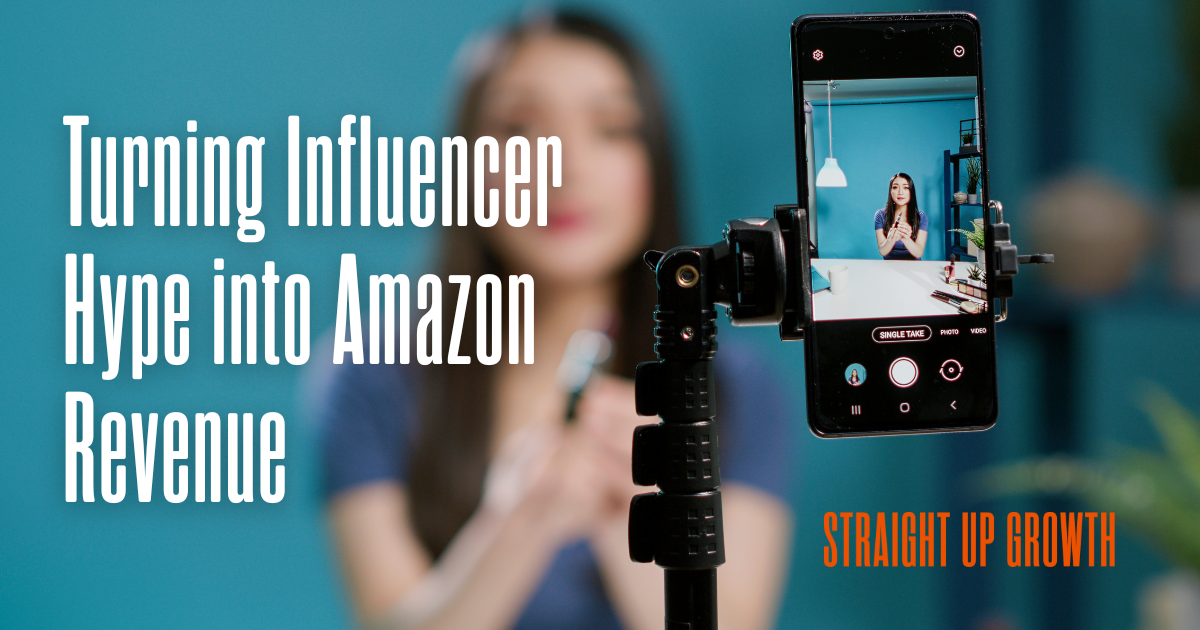Turning Influencer Hype into Amazon Revenue

The influencer marketing world is expanding rapidly and becoming more impactful. Projections from Influencer Marketing Hub show a rise from $21.1 billion in 2023 to $32.55 billion by the end of 2025. Influencer marketing plays a significant role in reshaping e-commerce by building trust and driving sales through authentic content. By partnering with influencers, brands can reach new audiences and boost conversions.
For Amazon sellers facing increased competition, evolving ad formats, and the constant need to differentiate their brand, influencer marketing has shifted from optional to essential. Influencers offer a high-ROI growth lever, allowing brands to cut through the noise, build trust with consumers, and ultimately drive sales on the platform.
I. The Power of Influencer Marketing
In influencer marketing, brands collaborate with people with an established online audience to expand brand awareness. This often means asking influencers to share content on social media that promotes the business's products or services. There are different types of influencers, including:
- Macro-influencers: Popular, larger followings (100K- 1 M followers)
- Micro-influencers: Niche, more engaged audiences (10K- 100K followers)
- Nano-influencers: Small, local followings (<10K followers).
Influencer marketing offers significant advantages, including authenticity, social proof, broader reach, and stronger customer trust. It often outperforms traditional digital advertising in ROI. For example, brands see an average of $5.78 for every $1 spent on influencer marketing, compared to Google Ads, which reports an average of $2 in revenue for every $1 spent.
II. Why Influencers Matter Specifically for Amazon Brands
- A. Influence Purchase Decisions on Amazon
Influencers play a crucial role in purchase decisions, particularly on Amazon, as they offer social proof, foster trust, and provide authentic recommendations that connect with consumers. Shoppers frequently research platforms like YouTube and TikTok before making a purchase decision. Despite the popularity of TikTok Shop, micro-influencers still effectively drive traffic to Amazon.
Additionally, influencer content is a powerful tool for driving branded search traffic and conversions. When influencers create content featuring a brand, their audience is more likely to search for that brand directly, increasing branded search volume. This increased visibility can translate into higher conversion rates as consumers become more aware of the brand and its offerings through trusted sources.
B. Boost Visibility and Rankings
Sending traffic to Amazon product listings from outside of Amazon, such as social media or ads, can improve organic rankings on Amazon. Amazon sees this external traffic as a signal that the product is popular and relevant, which can boost its ranking in search results.
Influencers play a significant role in this. When influencers recommend products and include links to Amazon listings, they're driving external traffic to Amazon. Amazon favors this and creates a "flywheel" effect: more external traffic leads to higher rankings, which leads to more sales, which in turn leads to even higher rankings and more traffic. Therefore, influencer referrals can help boost product visibility and sales on Amazon.
- C. Drive Engagement on Amazon Posts and Inspire Followers
Sharing content by influencers on Amazon Posts helps build brands. Amazon Posts is a feature on Amazon where brands can share content similar to social media posts. This helps increase brand visibility, credibility, and engagement with potential customers.
Furthermore, when people follow your Amazon storefront, they will get your brand’s updates on Amazon. Amazon can show your new products, deals, and content directly to your followers in their Amazon feed. This can be seen as free retargeting in the future, as you don’t have to pay for ads to reach these customers. Ultimately, it helps keep your brand top-of-mind and drive repeat purchases without spending extra money on advertising.
III. Influencers as Part of a Full-Funnel Amazon Ad Strategy
Influencers can play a role at every stage of your Amazon ad strategy:
- Top of Funnel (Awareness): Start with influencer-created content on platforms like Instagram, TikTok, and YouTube to make your brand known.
- Mid-Funnel (Consideration): Retarget those who clicked on influencer links using Sponsored Display or Amazon DSP. This keeps your product in their minds as they browse.
- Bottom of Funnel (Conversion): Incorporate influencer-generated content (UGC) in Sponsored Brand Videos or A+ Content on your product pages. This builds trust and encourages that final purchase.
IV. Best Practices for Working with Influencers as an Amazon Brand
As you explore working with influencers, keep these best practices in mind:
- Niche Alignment: Partner with creators whose audience and style naturally match your brand. Authenticity resonates with consumers and can help drive results.
- Track Everything: Use Amazon Attribution links to measure the direct impact of influencer campaigns on sales. Attribution provides data on which influencers drive traffic and conversions, allowing you to optimize your strategy.
- Build Long-Term Relationships: Prioritize "Always-On" partnerships over single posts to achieve consistent brand visibility. Consistent exposure builds brand recognition and trust.
- Maximize Content Value: Repurpose influencer content across your product detail pages (PDPs), ads, and social media for broader reach. Elevate your brand presence by leveraging influencer content to enhance product listings, social media, and ads.
V. Tools and Programs to Leverage
To effectively manage and optimize your influencer campaigns, consider incorporating these key tools and programs into your strategy:
- Amazon Influencer Program: Empower influencers to curate shoppable Amazon storefronts, driving traffic and sales directly to your products.
- Amazon Attribution: Track key metrics and attribute sales to specific content to gain valuable insights into the performance of your influencer campaigns.
- Creator platforms: Streamline influencer discovery, management, and campaign execution with partners like Trndstrs, Aspire, Upfluence, or the TikTok Creator Marketplace.
Final Thoughts
In today's market, influencers are the new word-of-mouth, acting as a vital link connecting brands with consumers on Amazon. To truly leverage this connection, shifting the focus from simple metrics, including likes, to measuring actual influencer impact is crucial. Prioritize strategies that drive increased traffic, higher conversion rates, and sustainable brand development for long-term growth.
Are you ready to elevate your Amazon Ads with influencer marketing? Contact Straight Up Growth to learn more about utilizing influencers in your Amazon Ads strategy!
Q+A
1. How can I track influencer traffic and sales on Amazon?
Use Amazon Attribution paired with unique tracking links to precisely measure the traffic and sales generated by each influencer directly on Amazon.
2. Do influencers need to be part of the Amazon Influencer Program to help my brand?
No, but it’s a bonus if they are. You can also work with creators outside the program.
3. Can I reuse influencer content in my Amazon ads and product pages?
Yes, you can reuse influencer content in your Amazon ads and product pages, but you get permission from the influencer first.
4. How do I find influencers to promote my Amazon products?
Search Amazon's program, social media, or influencer platforms using keywords related to your product to find relevant influencers, or check who's promoting your competitors. You could also work with an agency to find influencers.
5. What’s the difference between influencer content and brand content?
Influencer content is focused on authenticity and comes from the influencer's unique perspective, making it relatable to their audience. Brand content is more controlled and focuses on directly promoting the product or service, aligning with the brand's messaging and guidelines.
6. How do influencers drive sales on Amazon if they’re posting off-platform?
They link directly to your Amazon listings using affiliate or attribution links, driving warm traffic.
7. How can I measure ROI from influencer campaigns on Amazon?
Look at attribution link performance, branded search increases, and overall lift in sessions/sales.
8. Should I pay influencers or just offer free products?
It depends on their audience size and value—small creators may post for gifting, but paid collaborations often attract more commitment.




